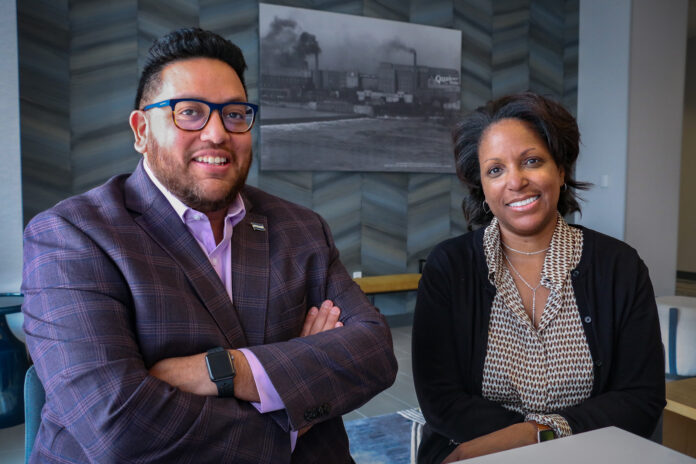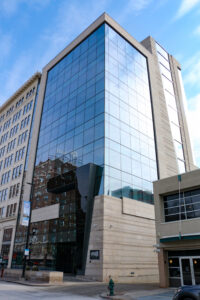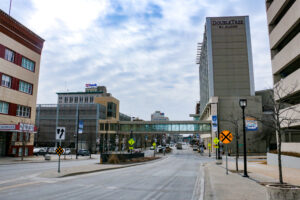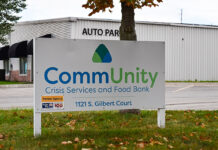
This is the first article of a two-part series examining the landscape of downtown Cedar Rapids and what the future might bring. Part 1, published today, is a profile of the Downtown District’s two leaders, their backgrounds, perspectives and ambitions. Part 2, to be published March 10, will involve a deeper dive on the city’s […]
Want to Read More?
Get immediate, unlimited access to all subscriber content and much more.
Learn more in our subscriber FAQ.
- Unparalleled business coverage of the Iowa City / Cedar Rapids corridor.
- Immediate access to subscriber-only content on our website.
- 26 issues per year delivered digitally, in print or both.
- Support locally owned and operated journalism.
Do you want to read and share this article without a paywall?
Click here to purchase a paywall bypass linkThis is the first article of a two-part series examining the landscape of downtown Cedar Rapids and what the future might bring. Part 1, published today, is a profile of the Downtown District’s two leaders, their backgrounds, perspectives and ambitions. Part 2, to be published March 10, will involve a deeper dive on the city’s Downtown Vision Plan, furthering the development of a new identity for downtown Cedar Rapids, addressing the downtown area’s challenges, and upcoming areas of focus.
Like most American cities, Cedar Rapids is working to chart a new future for its downtown district — one that, by necessity, will differ dramatically from its past.
And the two individuals tasked with leading that effort, Caleb Knutson and Jennifar Bassett, say they’re clearly aware of the challenges they face — and they’re prepared to take those challenges head-on.
“We’re a dynamic duo, but we’re just the point guards,” said Mr. Knutson, using a basketball analogy. “That’s it. We’re passing the ball, we’re facilitating, we’re getting those assists. Triple double, no points.”
Ms. Bassett joined the Downtown District as program manager in January 2024, while Mr. Knutson started as executive director in October after an analysis completed by the downtown Self-Supporting Municipal Improvement District (SSMID) indicated the city needed to better emphasize its downtown identity.

The two work side-by-side on behalf of the Downtown SSMID, created by downtown property owners in 1986 to improve the area’s streetscape and to encourage development.
The property owners within a SSMID, including the downtown SSMID, agree to pay additional property taxes each year, which are then used to fund improvements within the district.
Both leaders’ efforts are centered around the Downtown Vision Plan, a five-year outline of 70 initiatives meant to revitalize downtown. The plan was most recently updated in 2023.
While the vision plan’s goals are complex and ambitious, the Downtown District’s history is filled with a number of successes, as well as some challenges and unrealized goals. But Mr. Knutson and Ms. Bassett agree that a reimagined downtown Cedar Rapids, optimized for success in dramatically different circumstances, will bring a new era of success.
Divergent paths to Cedar Rapids
Mr. Knutson and Ms. Bassett bring different perspectives to their Downtown District roles — one a relative newcomer, the other a Cedar Rapids native.
Originally from Des Moines, Mr. Knutson is a graduate of Iowa State University with a master’s degree in community and regional planning. He arrived in Cedar Rapids after working as a senior planner with the Mid-Iowa Planning Alliance and, previously, as a city planner for the City of Marshalltown.
He said he was approached by a headhunter about the Downtown District role, and after guided tours from Ms. Bassett and the Economic Alliance, he developed an affinity for the city.
“In Iowa, this is a city where you want to be,” Mr. Knutson said. “This is a progressive place, not just for myself, but for my wife and our kids too. Everything fell into place. And when I got the offer, I was like, ‘oh, man, this is really happening.’ We talked about it as a family, and I’m here, so I’m super excited.”
Having visited Cedar Rapids several times in recent years, Mr. Knutson said the city is considered a “state darling” in economic development circles.
“My wife’s from Oregon, and she’s very familiar with walkable cities, and we’ve lived in different places,” he said. “We came to a wedding reception a couple of years ago and stayed at the DoubleTree. And walking back after the reception, I just said, ‘this is a pretty cool place.’ I’m a planner and an economic developer by trade, and with Cedar Rapids, there’s a lot of neat things going on.”
Meanwhile, Ms. Bassett, born and raised in Cedar Rapids, had lived out of state for several years before returning to her hometown.
“I’ve lived in Chicago, I’ve lived in Miami, I’ve lived in Phoenix,” she said. “I’ve spent the majority of my adult life outside of Cedar Rapids, and I recently relocated back to Cedar Rapids about three years ago to be closer to my family.”
Ms. Bassett explained that her brother’s wife had recently passed away, and she was able to spend more time with the family’s young children when she returned.
“It was actually a blessing to come back for my nephews, because I live right across the street from them, and it’s been great watching them grow up,” she said. “It’s definitely a different perspective for me, because I don’t have children, but I want there to be some sort of legacy for them here in Cedar Rapids. I want them to enjoy growing up here, because I did. I thought growing up here was great. It’s a great place to raise a family, it’s safe, it’s clean, a good education, all of those things, but I still needed to get out of Iowa and see bigger things.”
Living and working in other areas, Ms. Bassett said, helped deepen her appreciation of Cedar Rapids’ advantages.
“In larger cities, there’s not really a sense of community like you have in Cedar Rapids,” she said. “Coming back was actually really easy. I forgot about all of the people that I grew up with and people that knew me and my family. It was very welcoming coming back. And considering the work that we do is very social — there’s a lot of networking, a lot of building relationships — it’s been really helpful being able to leverage that for what we do, to build a better downtown and to make people want to come downtown. It’s changing. It’s learning people, it’s teaching them a different way. A lot of people that live in Cedar Rapids, or Iowa in general, haven’t really lived anywhere else. So when you leave and you come back, you see all the good things that bring you back, but also the areas of opportunity where you can bring some of that innovation to Cedar Rapids.”
Downtown perceptions often skewed
Mr. Knutson acknowledged that local residents don’t always have a positive view of the downtown area.
“People in Cedar Rapids have very low-self esteem about the city, but as an outsider, you come here and there’s just so many neat things going on,” Mr. Knutson said. “It’s vibrant. Your city and your organizations are progressive. They’re willing to try new things, and that’s incredibly exciting, whereas in older cities and cities that haven’t had natural disasters, they’re a little slower to steer the ship. For Cedar Rapids, in Iowa, this is the city where you want to be. There’s a lot going on. There’s just so much you can do. You can try new things, and people aren’t scared of that. In some areas, you can try new things, but you can’t swing for the fences. Here, you can definitely swing for the fences, and that’s incredibly exciting.”

Addressing that perception requires a multi-faceted approach, even when dealing with unsavory issues like bird droppings on downtown sidewalks, resistance to new parking technologies, or an overall impression that “there’s no reason for me to go downtown.”
“That’s a conversation that we have to have,” Mr. Knutson acknowledged. “That feeling exists. We’ve got to flip the script on that.”
As recently as the 1980s, downtown Cedar Rapids was known as a retail and a social hub, Ms. Bassett said.
“I spent a lot of time downtown when I was growing up,” she noted. “Smulekoff’s, Armstrong’s, City Hall. We were just always downtown doing something.”
Those days aren’t coming back — in Cedar Rapids or any other downtown district, Ms. Bassett said.
“The reality is that things change,” Ms. Bassett said. “What I see is really engaging our community in terms of how society is now. As young kids, we used to go to the mall and hang out at Westdale because it was two levels and you could see your friends there. Kids don’t go to the mall anymore. They’re tied to an Android or an iPhone. Technology is a big thing right now.
How do we cater to that, but at the same time, get them out a little more, get them out into the community, ride bikes, run around and play like we did, being social and innovative at the same time.”
It’s the job of Mr. Knutson and Ms. Bassett to help make that happen, to establish a new identity for downtown Cedar Rapids.
Taking advantage of strengths
While still a work in progress, Mr. Knutson and Ms. Bassett say they’re identifying the skills that will help them succeed in their new, relatively new roles.
Ms. Bassett said she tends to focus on downtown programming, as well as managing the Downtown District’s two-person maintenance team.
“As you get older, and especially in your professional career, you start to realize what you’re good at,” Ms. Bassett said. “My job is very complex, but it’s easy, because it’s part of who I am, when you can take who you are, your personality fits the role that you’re in. Caleb’s great with maneuvering parts of our job that I’m not. The politics of it — that’s not my jam, that’s his jam, and that’s a great compliment. For me, it’s like, you do that part, and I’d like to stay back here, making everything work.”
Mr. Knutson said his primary focus is making all the pieces fit together, between downtown stakeholders, policymakers and the SSMID board. He agreed, however, that he and Ms. Bassett continue to define their relative strengths that make them more effective as a team.
“Honestly, that’s a daily conversation that’s evolving,” he said. “There are some projects that just make sense for Jennifar to do or continue, there are some projects that make sense for me. It’s not an X, Y and Z, this is the game plan every day. It’s a conversation throughout our day. It’s a flexing sort of adaptation.”
Ms. Bassett said even as she’s creating programming for downtown spaces like Greene Square Park or Mays Island, she often looks to Mr. Knutson for ancillary assistance.
“I might ask Caleb if he could reach out to his connections,” she said. “Maybe we need a big sponsorship, or maybe we need somebody big to come up. It’s just different. I can’t really explain it other than the way that Caleb says it. It’s a day to day thing. Our roles do interchange a lot, but it’s still two really separate skill sets.”
“We’ll joke in the office — politicking is my thing,” Mr. Knutson said. “I’ll have that coffee, I’ll have that conversation, I’ll take that phone call or reply to that email. It’s just where I thrive. It’s what I enjoy doing, and that just happens to be part of my role now. But again, making sure that as a leader, I am supporting Jennifar and (maintenance supervisor) Evan (McGuire) and (maintenance specialist) Colin (Glandon) is incredibly important. I don’t think it can be stated enough that the people that you work with are assets, but they have a whole other purpose, and we’re making sure that we’re facilitating for them.
“I have always enjoyed policy,” he added. “I’ve always enjoyed legislation. So whenever I get the chance, I will jump at the opportunity to attend a legislative session or policy briefing. For me, it’s just having a conversation.”
Leading as people of color
Mr. Knutson also noted that having two people of color leading the Downtown District is an intense point of pride for him, as a Latino.
“You look at other organizations similar to us in the state, and you’re not going to see another organization where you have two people of color leading,” Mr. Knutson said. “I think that’s striking, that’s powerful. That’s important. It sends a message, not just to people in this community, but the next generation. If kids see us in these roles, they know ‘I can do that here. I don’t need to go to Austin. I don’t need to go to Nashville.’ You’ve got that in the second-largest city in the state of Iowa. They can recognize that we both have incredible talent, and they can also recognize the importance of lifting people up. I don’t think enough can be said about that."
Part 2 of this series, a deeper dive on the city’s Downtown Vision Plan, will be published on March 10. CBJ subscribers can read this in print or online.




